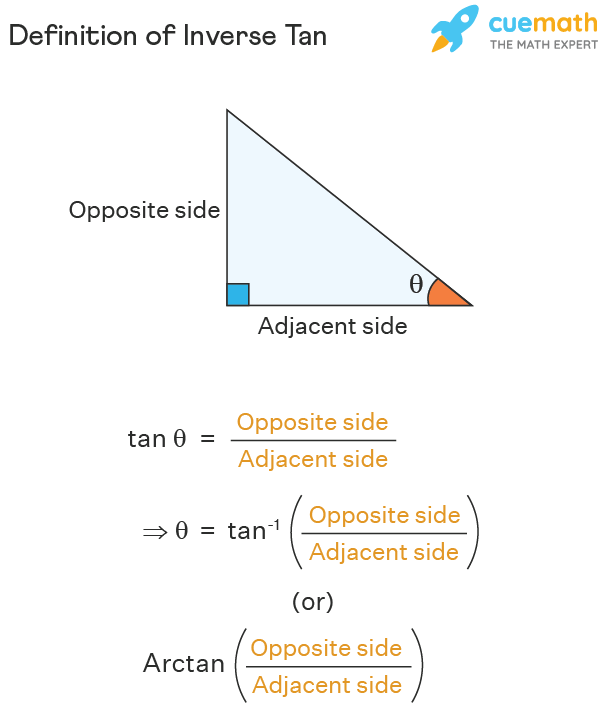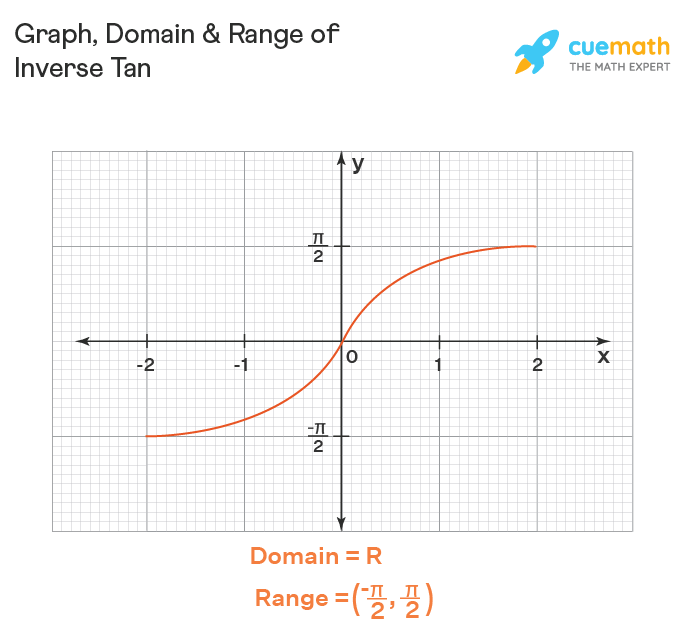
Inverse tan is one of the inverse trigonometric functions and it is written as tan -1 x and is read as "tan inverse x". It is also known as arctan (x). We have 6 inverse trigonometric functions that correspond to six trigonometric functions. The inverse tan function is one among them.
Here, we will study in detail about the inverse tan function (arctan) along with its properties, graph, domain, and range. Also, we will learn the formulas, derivative, and integral of tan inverse x along with a few solved examples.
| 1. | What is Inverse Tan? |
| 2. | Inverse Tan Formula |
| 3. | Domain, Range, and Graph of Inverse Tan |
| 4. | Steps to Find Tan Inverse x |
| 5. | Properties of Inverse Tan |
| 6. | Derivative of Inverse Tan |
| 7. | Integral of Inverse Tan |
| 8. | FAQs on Inverse Tan |
The inverse tan is the inverse of the tan function and it is one of the inverse trigonometric functions. It is also known as the arctan function which is pronounced as "arc tan". It is mathematically written as "atan x" (or) "tan -1 x" or "arctan x". We read "tan -1 x" as "tan inverse x". If two functions f and f -1 are inverses of each other, then whenever f(x) = y , we have x = f -1 (y). So tan x = y ⇒ x = tan -1 (y). i.e., when "tan" moves from one side to the other side of the equation, it becomes tan -1 . Let us consider a few examples to see how the inverse tan function works.
In a right-angled triangle, the tangent of an angle (θ) is the ratio of its opposite side to the adjacent side. i.e., tan θ = (opposite side) / (adjacent side). Then by the definition of inverse tan, the inverse tan formula is, θ = tan -1 [ (opposite side) / (adjacent side) ] .

Thus, the inverse tan formula is used to find the angle in a right-angled triangle when the opposite side and the adjacent side are given.
In this section, let us see how we can find the domain and range of the inverse tan function. Also, we will see the process of graphing it.
We know that the tan function is a function from R - to R. (This is because the tan function is NOT defined for odd multiples of π/2). But tan function is NOT one-one on its domain and so its inverse does not exist over this domain. For the tan function to be one-one, its domain can be restricted to one of the intervals (-3π/2, -π/2), (-π/2, π/2), (π/2, 3π/2), etc. With respect to each of these intervals, we get a branch of the inverse tan. But the domain of tan function is usually restricted to (-π/2, π/2) to make it one-one. i.e., tan x : (-π/2, π/2) → R.
The domain and range of the tan function are the range and domain of its inverse tan function respectively. i.e., arctan x (or) tan -1 x : R → (-π/2, π/2). Therefore,
The graph of the inverse tan function with its range to be the principal branch (-π/2, π/2) can be drawn using the following table. Here, we have chosen random values for x in the domain of tan inverse x which is R.
| x | y = tan -1 x |
|---|---|
| -2 | tan -1 (-2) = -tan -1 (2) ≈ -1.107 |
| -1 | tan -1 (-1) = -tan -1 (1) = -π/4 ≈ -0.78 |
| 0 | tan -1 (0) = 0 |
| 1 | tan -1 (1) = π/4 ≈ 0.78 |
| 2 | tan -1 (2) ≈ 1.107 |
By plotting these points on the graph, we get the graph of the inverse tan.

Here are the steps to find the tan inverse of x.
Here are a few examples through which we can understand how to find tan inverse x.
Note that tan -1 x should always result in some angle that lies in the interval (-π/2, π/2).
You can find the inverse tan of any value using this Inverse Tan Calculator. You can try using this calculator.
Here are some properties/formulas of inverse tan. These are very helpful in solving the problems or proving the identities in trigonometry.
Let us find the derivative of y = tan -1 x. By the definition of inverse tan, y = tan -1 x can be written as tan y = x. We differentiate this on both sides with respect to x using the chain rule. Then we get
sec 2 y (dy/dx) = 1
dy/dx = 1/sec 2 y . (1)
Now, we have sec 2 y - tan 2 y = 1 ⇒ sec 2 y = 1 + tan 2 y = 1 + x 2
Substituting this in (1),
dy/dx = 1 / (1 + x 2 )
Thus, the inverse tan derivative (or) the derivative of tan inverse x is 1 / (1 + x 2 ).
We will find ∫ tan -1 x dx using the integration by parts. For this, we write the above integral as
Using LIATE, u = tan -1 x and v' = 1 dx.
Then du = 1/(1 + x 2 ) dx and v = x.
Using integration by parts,
∫ u dv = uv - ∫ v du
∫ tan -1 x · 1 dx = tan -1 x (x) - ∫ x/(1 + x 2 ) + C
∫ tan -1 x dx = x tan -1 x - ∫ x/(1 + x 2 ) + C
We will calculate the integral on the right side using u-substitution method. For this, assume that 1 + x 2 = u. Then 2x dx = du (or) x dx = du/2.
∫ tan -1 x dx = x tan -1 x - ∫(1/u) (1/2) du + C
= x tan -1 x - (1/2) ln|u| + C
= x tan -1 x - (1/2) ln |1 + x 2 | + C
Therefore, ∫ tan -1 x dx = x tan -1 x - (1/2) ln |1 + x 2 | + C.
Important Notes on Inverse Tan:
☛ Related Topics:
Example 1: If θ is an acute angle in a right triangle whose opposite side is 4 units and the adjacent side is 4 units as well, find θ. Solution: We know that tan θ = (opposite side) / (adjacent side) = 4/4 = 1. From the definition of inverse tan, θ = tan -1 (1) = π/4 (or) 45°. This is because tan π/4 (or) tan 45° = 1. Answer: θ = π/4 (or) 45°.
Example 2: Find the values of the following: a) tan (tan -1 2) b) tan -1 (tan 3π/2). Solution: a) We know that tan (tan -1 x) = x for all x. Therefore, tan (tan -1 2) = 2. b) We know that tan -1 (tan x) is NOT defined when x is an odd multiple of π/2. Here 3π/2 is an odd multiple of π/2. So tan -1 (tan 3π/2) is NOT defined. Answer: a) tan (tan -1 2) = 2 b) tan -1 (tan 3π/2) is NOT defined.
Example 3: Prove the following: tan -1 (2/11) + tan -1 (1/2) = tan -1 (3/4). Solution: Here, (2/11) × (1/2) = 1/11 < 1. We know that tan -1 x + tan -1 y = tan -1 [(x + y)/(1 - xy)], when xy < 1. Substituting x = 2/11 and y = 1/2 in this, tan -1 (2/11) + tan -1 (1/2) = tan -1 [(2/11 + 1/2)/(1 - (2/11)(1/2))] = tan -1 ( (15/22) / (10/11) ) = tan -1 (3/4) Answer: We have proved that tan -1 (2/11) + tan -1 (1/2) = tan -1 (3/4).
View Answer >
Indulging in rote learning, you are likely to forget concepts. With Cuemath, you will learn visually and be surprised by the outcomes.